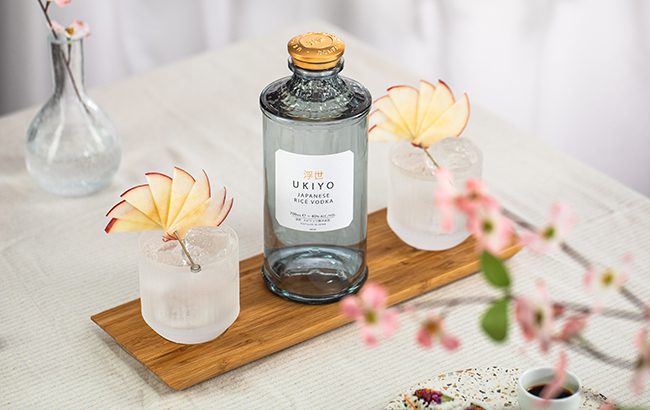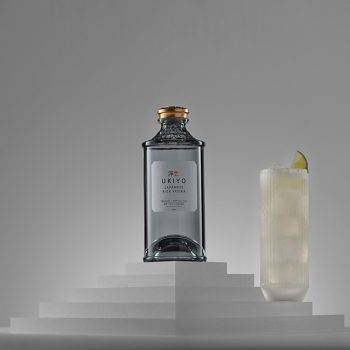SB meets… Ukiyo Japanese Rice Vodka
By Lauren BowesUkiyo Japanese Rice Vodka blew away our judges last year and took home the title of The Vodka Taste Master 2024, praised for its “silky, soft and gentle palate”.

Launched in late 2021, this rapidly growing Japanese brand is gaining global recognition. Owned and distributed by Kirker Greer Spirits, part of the Drinksology Kirker Greer (DKG) Group, its portfolio includes three gins – Tokyo Dry (Classic Dry Gin), Blossom (Floral Dry Gin) and Yuzu (Citrus Dry Gin) – and one vodka, its flagship rice-based expression. Each is crafted to celebrate the flavours, customs and traditions of Japan, but as a modern interpretation.
We spoke to DKG’s CEO Richard Ryan (RR) and chief marketing officer Ali Pickering (AP) to find out how the award-winning vodka is made, how it differs from other brands on the market and what lies in the future.
Ukiyo Japanese Rice Vodka was praised for being a “great example of a rice spirit” – how is it made?
RR: Our Ukiyo Japanese Rice Vodka is crafted from a base of rice – awamori – a traditional distilled spirit in Japan. It is distilled in small batches and creates a smooth, delicate spirit with soft, sweet and floral characteristics, complemented by subtle hints of violet and citrus.
In Japan, rice is renowned for producing the purest spirit; it brings a smoother and silkier mouthfeel, alongside greater depth and complexity – making Ukiyo Japanese Rice Vodka a sophisticated alternative to traditional grain vodkas.
Rice plays a key role across a range of domestic drinks in Japan, like sake. It’s also used in other brewed drinks, including amazake. For distilled products, there’s shochu, which is the biggest-selling distilled drink in Japan – while this can be made from many different things, it’s very often made from rice.
Then there’s awamori, which is geographically indexed to the Okinawa prefecture. We chose this base spirit for our Ukiyo Japanese Rice Vodka. The reason for that was manifold, but mostly because of its very strong rice-forward profile, combined with its texture and mouth feel. It has such a strong taste profile that even when we redistill it, much of the prized rice flavour is retained.
When awamori is first produced, it typically sits at around 25% to 30% ABV before being aged in clay pots. Some awamori are aged for a very long time, but we chose a short ageing process since we intended to redistill it. It’s aged for a few months, which helps to bring out the qualities we want and ensure a mellower spirit ahead of redistillation. It really is a very flavoursome base spirit for a vodka – offering real sweetness and a floral profile.
Which came first, the gin or the vodka?
RR: They were pretty much at the same time. Ukiyo Blossom and Ukiyo Yuzu Gins were launched in September 2021 and Ukiyo Vodka followed closely behind in December 2021. The vodka was a lovely way for us to tell our story, because it showcased our use of rice as a singular expression. We also use rice spirit in the base of our gin expressions, before layering in five native Japanese botanicals expressing the diverse terroir and tastes found in the country’s mountains and coastlines. We use yuzu peel, mikan peel, sakura flower, sakura leaf and sansho pepper, which are further complemented by traditional gin botanicals including juniper, pepper, coriander, angelica root, lemon peel, cardamom and rosemary.

Have you noticed any shifts in consumer preferences for vodka?
AP: One of the key trends we’re seeing, both from our research and across the industry, is a strong preference among consumers and bartenders for spirits with authentic provenance – with a notable focus on offerings from Asia, especially Japan. This has been confirmed through research groups, as well as through our direct-to-consumer platform, Spiritly.
Another indicator of this trend is engagement on our social media channels. When we feature bartenders using our Ukiyo products and sharing their cocktail recipes, we see high levels of interaction – many people save these posts, reinforcing the appeal of these spirits.
Beyond provenance, vodka’s versatility remains a key factor in its success. It’s quite often a blank canvas. While our Ukiyo Vodka has a unique taste profile, it still offers that universal versatility.
The category is also continuing to attract a younger audience, which comes with an increased consciousness around moderation. We’re seeing growing demand for longer, more refreshing serves, and vodka is a brilliant spirit for that.
The premium and super-premium space used to be a speeding train showing no signs of slowing, but we’re seeing that lose pace a bit now. That’s great for Ukiyo, as it falls into the ‘accessible premium’ category, offering consumers high quality and uniqueness at an affordable price.
Is the brand seeing more success in the on- or off-trade?
AP: I’ve spent more than two decades in the drinks industry – brands were typically always built in the on-trade because the serve and the experience are great, and you have more control over what you can deliver. When Covid came along, that particular bubble burst. It’s more of a dual path now; we’re seeing one inform the other.
People are getting good experiences on either side now. Consumer confidence is really building with experimenting at home – long may that continue.
RR: We launched Ukiyo right at the tail end of Covid, so our plans had to be balanced. At that point, the on-trade was still recovering. People were firefighting just to get their staple brands, never mind luxury offerings.
For an independent company, it can be difficult to compete in the on-trade. We’re up against a lot of very big businesses with large budgets. One thing we’ve always had – to our credit – is a team of highly experienced creatives in-house as part of our Drinksology creative agency. We use this expertise as our way to take a step up. Our team has played a role in delivering the World’s Best Cocktail Bar three times, following our bar design consultancy work with Belfast’s Merchant Hotel’s bar and The Dead Rabbit in New York. There are lots of things we can do through our knowledge to compete, rather than having the financial clout of large players like Diageo or Pernod Ricard.
What markets have been receptive to Ukiyo?
AP: Ukiyo is available in more than 30 markets worldwide, either directly or indirectly. Ukiyo’s home of Japan still remains quite a small market for vodka, and so while we’re looking to broaden there, we’re seeing the strongest opportunities in other markets at the moment. These include the UK, Ireland, the Netherlands, Germany, Australia and Singapore. We’re also prospecting in the Nordics, India and Indonesia, where we’re looking to drive brand recognition and awareness.
Do you think there will be any line extensions for the vodka?
RR: We’ve actually been approached by a very well-known bar group to explore potential line extensions specifically for them, which could open up exciting opportunities down the line. For now, though, we’re fully focused on the core expression of the brand. If we were to expand, I don’t think it would be through flavours, which feel like they’ve had their moment. Instead, we’d likely explore profiling different base spirits, perhaps something uniquely Japanese. While that kind of R&D for Ukiyo Vodka isn’t in the immediate future, we’re constantly exploring new innovations and line extensions across the Kirker Greer Spirits portfolio, so it’s certainly something we’re keeping on our radar.
Related news
Spy X Vodka debuts in Hong Kong
